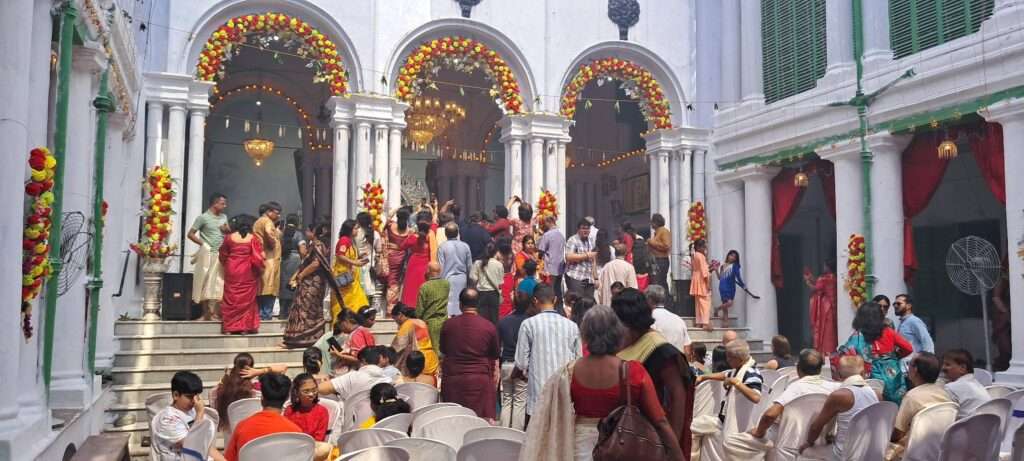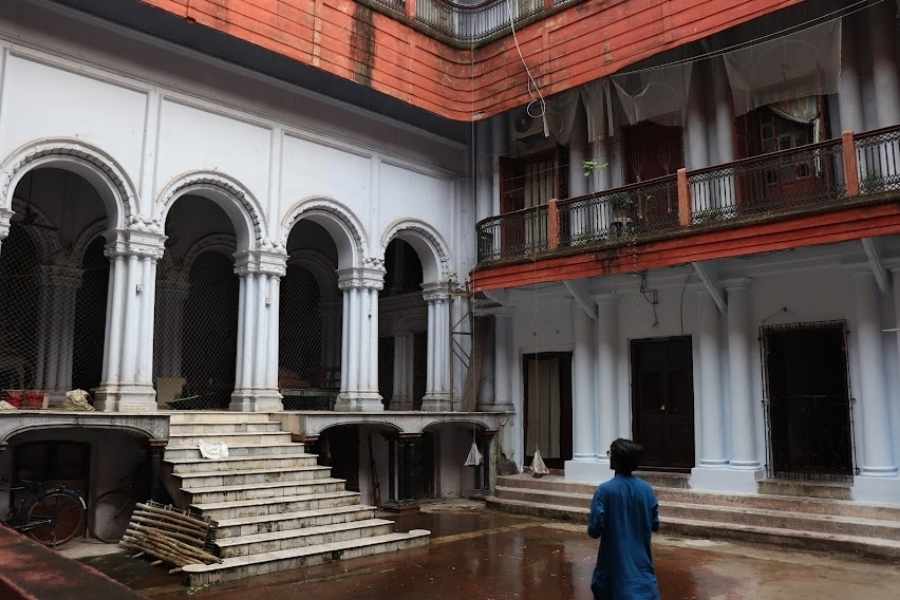
Dorjipara Mitrabari Durga Puja: A Legacy Carved in Devotion
Share
In the heart of North Kolkata, tucked away from the clamorous grandeur of public pandals, exists a sacred space where time seems to pause every autumn. The Dorjipara Mitrabari Durga Puja is not just a religious event — it is a legacy woven into the very soul of Bengal’s Bonedi (aristocratic) households.

It is a celebration where rituals breathe history, where artistry honors ancestry, and where devotion is deeply, intimately personal.
A Legacy Rooted in Royal and Cultural Ties
The origins of this Bonedi Bari can be traced back to Jagannath Prasad Mitra, who migrated to the Sutanuti area (present-day North Kolkata) for trade. Though little is recorded about his enterprise, his grandson Durgacharan Mitra rose to prominence as the court jeweler of Nawab Siraj-ud-Daulah, placing the family in the orbit of Bengal’s aristocracy and cultural elite.
The family’s fortunes later took a tragic turn when Nilmoni Mitra, a respected figure in colonial Calcutta, was allegedly framed by the British and stripped of his assets. His daughter-in-law, with three young sons, returned to Kolkata and took shelter at Durgacharan’s residence. Here, history quietly pivoted — the eldest son playfully created a Kali idol with unique features, and the household’s centuries-old Kali Puja tradition was born.

The second son, Radhakrishna Mitra, would later emerge as a formidable businessman. Marrying into the family of Ram Dulal De Sarkar, one of Bengal’s wealthiest merchants, Radhakrishna formed a strong export-import alliance with the British. His contributions were so noteworthy that a bust of him was installed at the P. Bod Library in Bristol — a rare honor for an Indian businessman of the time. His son, Rajkrishna Mitra, continued the family’s commercial legacy by establishing the firm “Radhakissen & Rajkissen Co.”
The Birth of Durga Puja at Mitrabari
In 1806, the family constructed their iconic Thakur Dalan — a five-pillared prayer hall — within their home on Nilmoni Mitra Street. That very year, they hosted their first grand Durga Puja, marking the beginning of what is now over two centuries of uninterrupted tradition. Unlike the towering public installations seen across Kolkata, this is a Puja celebrated within the intimacy of a family courtyard — rooted, minimalist, and profoundly meaningful.
Khuti Puja to Dashami: Rituals That Transcend Time
The festivities commence on Rath Yatra with Khuti Puja, where a bamboo pole is worshipped — this forms the spiritual base for the idol to come. It is a ritual full of anticipation, marking the official start of Pujo preparations. The household’s presiding deity, Sri Sri Rajrajeshwar Jew, is also worshipped with deep reverence.
What follows is an intricate process of idol creation, deeply intertwined with the family’s traditions:

- Idol Making: The idol is always crafted by the same artisan family from Kumortuli, a tradition passed down through generations.
- Mothchouri Chali: The backdrop (chalchitra) is a rare design known as Mothchouri Chali — with three distinct peaks representing the Hindu Trinity. Adorned in black and gold potochitro, it is both minimalist and regal, deeply symbolic of Bengal’s folk-art tradition.
- Human-Like Features: Devi Durga is sculpted with soft, human-like features, as is Mahishasura — breaking away from the ferocious imagery popular in modern depictions. Even the lion, her mount, is crafted with a horse-like face — a subtle signature of the Mitrabari iconography.
- Ornamentation: The deities are adorned exclusively by family members, a practice that replaced the Krishnanagar artisans of the past, infusing the celebrations with personal emotion and ancestral continuity.
- The Daughter Returns Home
At Mitrabari, Durga is not a distant deity — she is the beloved daughter who returns home during Sharad season. Preparations begin as early as winter, with family members making seasonal pickles and sweets — all dedicated to welcoming her. The connection is not ceremonial but deeply maternal.
One poignant tradition that defines the Mitrabari Puja is the discontinuation of animal sacrifice. Legend has it that a frightened goat, meant to be sacrificed, sought refuge at Rajkrishna Mitra’s feet. Touched by the moment, the family renounced the practice and replaced it with offerings of sugar and symbolic butter-sugar “noibidyo” sculpted into miniature temple designs — still lovingly prepared today.
Sandhi Puja with Aparajita Flowers
Another distinct ritual takes place during Sandhi Puja (the sacred juncture between Ashtami and Navami). Instead of the traditional lotus flowers, 108 Aparajita blossoms — a rare forest jasmine — are offered. As each flower is placed at the Goddess’s feet, her 108 names are chanted, creating an atmosphere of unmatched spiritual intensity. This is not just a ritual — it’s an invocation, a meditative dialogue with the divine.

The Final Day: Dashami and Immersion
On Dashami, as the Goddess prepares to return to her cosmic abode, emotions run high. She is offered fragrant betel leaves, while the gods and goddesses are given ‘jharkhili’, a sacred parting token. The men of the family, dressed in traditional white dhotis and barefoot, carry the idols on their shoulders. The immersion, unlike the loud processions of public pujas, is a silent, heartfelt farewell.

In the past, the ‘Nilkantha’ (Indian Roller) birds were released — one toward the heavens to inform Shiva of Durga’s departure, and the other back home to invite her return. Though the practice has faded, its symbolism lingers.
Once the idols are immersed, women of the family sit on Durga’s empty throne, believing her power and blessings have now been transferred to them — a beautiful representation of Shakti within the everyday woman.
Why Bonedi Pujas Like Mitrabari Matter
As commercial pandals race toward innovation and spectacle, Bonedi Bari Pujas like that of Dorjipara Mitrabari serve as cultural sanctuaries. They protect the original soul of Durga Puja — not in sound and light, but in storytelling, memory, and love. Here, every ritual has a reason, every heirloom has a history, and every moment is soaked in reverence.

Today, this Puja stands as one of the most revered private celebrations in Kolkata, inviting culture lovers, heritage enthusiasts, and spiritual seekers to witness a Durga Puja experience that is quiet, profound, and timeless.
